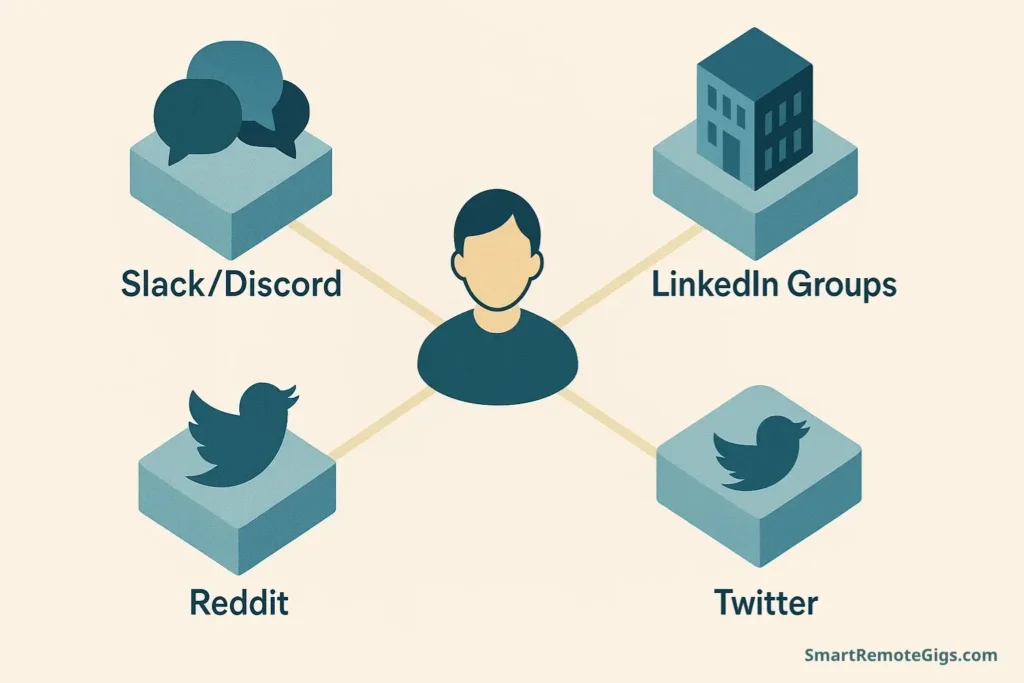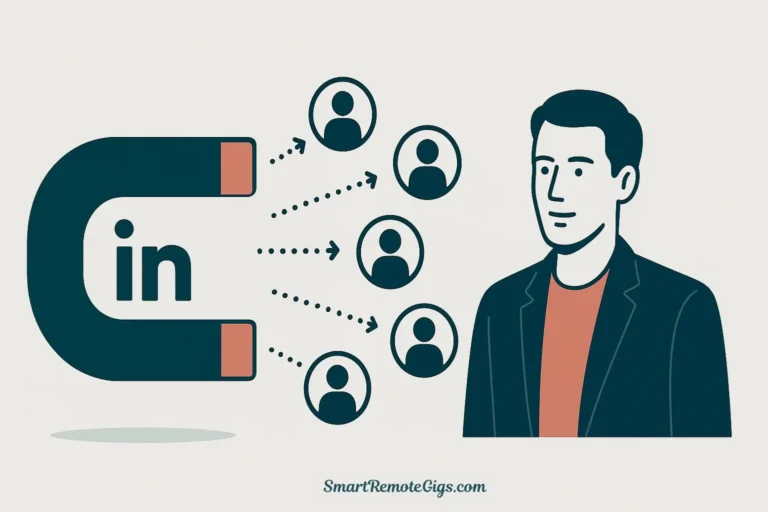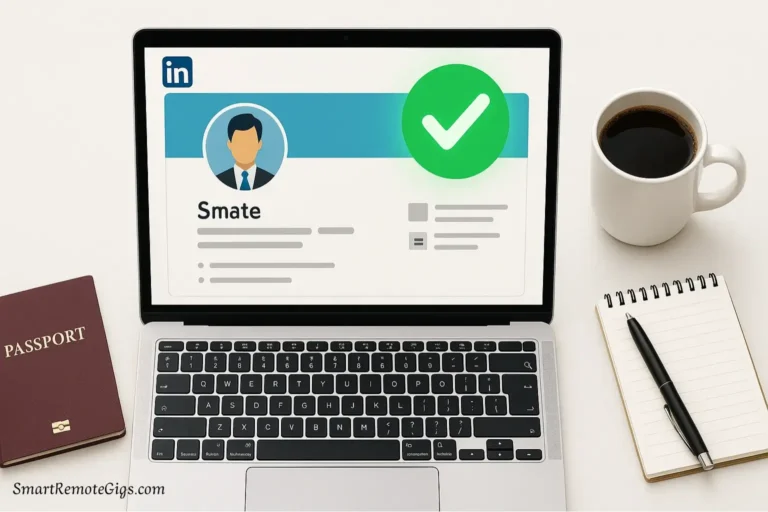The hallway conversations are gone. No more impromptu coffee breaks with colleagues or chance encounters at industry events. As remote work becomes the new normal, many professionals feel isolated from the career-boosting connections that once happened naturally in office environments. Yet here’s the surprising truth: virtual networking can actually build stronger, more meaningful professional relationships than traditional in-person networking ever could.
This comprehensive guide to virtual networking will show you exactly how to build powerful professional connections from your home office. Whether you’re a seasoned remote worker or new to distributed teams, these proven strategies will help you expand your network, advance your career, and create lasting professional relationships that transcend geographical boundaries.
In the next 10 minutes, you’ll discover the mindset shift that transforms networking from awkward self-promotion into genuine relationship building, learn where to find your professional tribe online, master the art of virtual coffee chats, and develop a system for maintaining relationships that compound over time. Let’s dive into the strategies that successful remote professionals use to network their way to career success.
The Mindset: Give More Than You Take

The biggest mistake remote professionals make in online networking remote work is approaching it with a scarcity mindset—frantically trying to extract value from every interaction. This transactional approach not only feels inauthentic but actively repels the very people you’re trying to connect with.
The Abundance Networking Philosophy
Successful virtual networkers operate from a fundamentally different paradigm: they focus on giving first, asking second. This abundance mindset transforms networking from uncomfortable self-promotion into genuine relationship building that feels natural and sustainable.
The Psychology Behind Giving First:
- Creates immediate goodwill and trust
- Positions you as a valuable connection
- Activates the reciprocity principle in human psychology
- Builds your reputation as a generous professional
- Attracts opportunities rather than chasing them
Practical Ways to Give First
Share Valuable Resources:
- Industry articles with thoughtful commentary
- Tool recommendations based on your experience
- Job opportunities that aren’t right for you but perfect for others
- Event invitations and speaking opportunities
- Introductions between people who should know each other
Offer Your Expertise:
- Answer questions in professional communities
- Provide feedback on others’ projects or ideas
- Share lessons learned from your mistakes
- Mentor newcomers in your field
- Participate in industry discussions with valuable insights
Amplify Others’ Success:
- Celebrate colleagues’ achievements publicly
- Recommend others for speaking opportunities
- Share and comment on others’ content meaningfully
- Write LinkedIn recommendations for deserving professionals
- Nominate others for awards or recognition
The Compound Effect of Generous Networking
When you consistently give value without immediate expectation of return, something remarkable happens: you become known as a connector and valuable resource. This reputation attracts opportunities, referrals, and high-quality connections that seek you out rather than the other way around.
Data Insight: According to a study by Harvard Business Review, professionals who adopt a “giver” approach to networking are 40% more likely to receive job offers and promotion opportunities compared to those who focus primarily on self-promotion.
Your Arenas: Where to Find Your People

The key to successful virtual networking lies in being strategic about where you invest your time and energy. Rather than spreading yourself thin across every platform, focus on 2-3 high-quality arenas where your target connections are most active and engaged.
Slack Communities: The New Water Cooler
Slack communities have become the virtual equivalent of industry conferences—concentrated spaces where professionals gather to share knowledge, discuss trends, and build relationships. Unlike social media platforms, Slack communities foster deeper, more meaningful conversations.
Top Professional Slack Communities:
Community | Focus Area | Size | Best For |
|---|---|---|---|
Women in Tech | Technology, diversity | 50,000+ | Female tech professionals |
Remote Work Hub | Remote work strategies | 25,000+ | Distributed team leaders |
Marketing Professionals | Digital marketing | 30,000+ | Marketers and growth experts |
Developer Hangout | Software development | 40,000+ | Programmers and engineers |
Startup Grind | Entrepreneurship | 35,000+ | Founders and startup employees |
Slack Community Engagement Strategy:
- Lurk first: Spend 1-2 weeks observing conversation patterns and community norms
- Add value consistently: Share relevant resources and insights regularly
- Ask thoughtful questions: Pose questions that generate meaningful discussions
- Help others: Respond to questions within your expertise area
- Direct message sparingly: Only reach out privately after establishing public rapport
Pro Tip: Join communities like Women in Tech Chat or Marketing Professionals to experience high-quality professional Slack communities firsthand.
LinkedIn Groups: Professional Depth
While LinkedIn’s algorithm has changed, LinkedIn Groups remain valuable for virtual networking tips and industry-specific discussions. The key is finding active groups with engaged members rather than promotional ghost towns.
Identifying High-Value LinkedIn Groups:
- Active daily discussions with multiple comments per post
- Industry leaders regularly participating in conversations
- Quality over quantity in posts (fewer promotional posts, more valuable content)
- Engaged moderation that maintains community standards
- Relevant job postings and opportunity sharing
LinkedIn Group Engagement Best Practices:
- Comment thoughtfully on others’ posts before sharing your own content
- Share industry insights and analysis rather than promotional material
- Ask questions that demonstrate expertise while seeking others’ perspectives
- Participate in group discussions regularly rather than sporadically
- Connect with interesting group members after meaningful interactions
Twitter: Real-Time Industry Pulse
Twitter’s fast-paced environment makes it perfect for staying current with industry trends and connecting with thought leaders. The platform’s public nature allows you to engage with industry giants who might be inaccessible through other channels.
Twitter Networking Strategy:
- Follow industry hashtags relevant to your field (#RemoteWork, #TechCareers, #MarketingTips)
- Engage with thought leaders by adding valuable commentary to their tweets
- Share industry insights with your unique perspective and experience
- Participate in Twitter chats for real-time industry discussions
- Host Twitter Spaces to position yourself as a thought leader
Twitter Engagement Tactics:
- Reply with thoughtful questions or insights rather than generic comments
- Share others’ content with your own commentary added
- Create Twitter threads that provide value to your industry
- Use relevant hashtags to increase discoverability
- Engage consistently rather than in sporadic bursts
Reddit: Niche Community Expertise
Reddit’s subreddit structure allows for highly targeted networking within specific niches. While the platform can be more casual, many subreddits host serious professional discussions and networking opportunities.
High-Value Professional Subreddits:
- r/RemoteWork (400k+ members): Remote work strategies and opportunities
- r/cscareerquestions (500k+ members): Software development career advice
- r/marketing (200k+ members): Digital marketing discussions and tips
- r/entrepreneur (800k+ members): Startup and business building advice
- r/freelance (150k+ members): Independent contractor community
Reddit Networking Approach:
- Provide detailed, helpful answers to questions in your expertise area
- Share valuable resources and tools you’ve discovered
- Participate in “Ask Me Anything” sessions with industry experts
- Create valuable posts that spark meaningful discussions
- Direct message only after establishing credibility through public contributions
The Technique: How to Engage Without Being Annoying

The line between valuable networking and annoying self-promotion is thinner online than in person. Without body language and voice tone, your intentions can be easily misinterpreted. Master these engagement techniques to build genuine connections without coming across as pushy or inauthentic.
The Value-First Approach
Before reaching out to anyone, ask yourself: “What value can I provide to this person?” This simple question transforms your networking from extractive to generative, immediately improving your success rate and relationship quality.
Value-First Engagement Framework:
- Research thoroughly: Understand their work, challenges, and interests
- Identify value opportunities: Find ways to help before asking for anything
- Craft personalized outreach: Reference specific aspects of their work or content
- Offer something concrete: Provide a resource, introduction, or insight
- Ask for nothing initially: Focus purely on giving value first
The Art of Asking Questions
Questions are the secret weapon of successful virtual networkers. They demonstrate genuine interest, showcase your expertise, and create natural opportunities for deeper conversation.
Effective Networking Questions:
For Industry Discussions:
- “What’s your take on [current industry trend]? I’ve been seeing [specific observation]…”
- “How are you approaching [common challenge]? I’m curious about your strategy…”
- “What tools/resources have you found most valuable for [specific area]?”
For Community Engagement:
- “Has anyone else experienced [specific challenge]? I’d love to hear different approaches…”
- “What’s the most surprising thing you’ve learned about [relevant topic] recently?”
- “Who in this community should I be following for insights on [specific area]?”
For Direct Outreach:
- “I noticed your work on [specific project]. How did you approach [specific aspect]?”
- “Your recent post about [specific topic] resonated with me because [personal connection]…”
- “I’m working on something similar to [their work]. Would you mind sharing your biggest lesson learned?”
The AIDA Networking Method
Adapt the classic AIDA marketing framework for networking success:
Attention: Grab their attention with something relevant and specific Interest: Share something that demonstrates your expertise or provides value Desire: Create desire for continued conversation by hinting at mutual benefits Action: Suggest a specific, low-commitment next step
Example AIDA Networking Message: “Hi Sarah, I noticed your excellent thread about remote team management challenges (Attention). I’ve been implementing a similar framework at my company and found that adding async video updates reduced our meeting time by 40% (Interest). I’d love to compare notes on what’s working for different team structures (Desire). Would you be open to a brief virtual coffee chat next week? (Action)”
Engagement Frequency and Timing
The 5-Touch Rule: Aim for 5 meaningful interactions before making any significant ask. This builds rapport and establishes your credibility.
Optimal Engagement Timing:
- Slack Communities: Peak activity during business hours in the community’s primary timezone
- LinkedIn: Tuesday-Thursday, 8-10 AM and 12-2 PM
- Twitter: Weekdays 9 AM-3 PM, with peak engagement around lunch time
- Reddit: Evenings and weekends when people have time for longer discussions
Engagement Frequency Guidelines:
- Daily: Monitor and respond to comments on your content
- 3x per week: Actively participate in community discussions
- Weekly: Reach out to 2-3 new potential connections
- Monthly: Audit your networking activities and adjust strategy
The Ultimate Move: Mastering the Virtual Coffee Chat

The virtual coffee chat is the crown jewel of remote networking—a low-pressure, high-value interaction that can transform casual connections into career-changing relationships. Unlike traditional networking events, virtual coffee chats allow for deeper, more meaningful conversations without the distractions of crowds or time pressure.
Why Virtual Coffee Chats Work
Psychological Advantages:
- Intimacy: One-on-one conversation creates deeper connection
- Comfort: People are more relaxed in their own environment
- Focus: No distractions from other networking opportunities
- Flexibility: Easy to schedule across time zones and busy schedules
- Authenticity: Casual format encourages genuine conversation
Professional Benefits:
- Quality over quantity: Deep relationships trump superficial connections
- Mutual learning: Both parties gain valuable insights
- Relationship foundation: Creates basis for ongoing professional relationship
- Referral potential: Happy connections become your advocates
- Skill development: Improves your networking and communication abilities
The Perfect Virtual Coffee Chat Outreach Script
Subject Line: “Quick virtual coffee? [Specific commonality/reason]”
Template:
Hi [Name],
I've been following your work on [specific project/content] and particularly appreciated your insights about [specific detail]. As someone who's also [relevant connection/experience], I found your perspective really valuable.
I'd love to learn more about your approach to [relevant topic] and share some insights from my experience with [your relevant experience]. Would you be open to a brief virtual coffee chat?
I'm flexible on timing and can work around your schedule. We could keep it to 20-30 minutes to respect your time.
Looking forward to connecting!
Best,
[Your name]
Key Elements:
- Specific reference to their work (shows genuine interest)
- Relevant connection (establishes common ground)
- Mutual benefit (not just extractive)
- Flexible timing (respects their schedule)
- Clear duration (reduces commitment anxiety)
Virtual Coffee Chat Structure
Pre-Chat Preparation (5 minutes):
- Research their background and recent work
- Prepare 3-4 thoughtful questions
- Test your technology setup
- Prepare your workspace for video call
Opening (5 minutes):
- Warm greeting and appreciation for their time
- Brief personal introduction if needed
- Confirm the agenda and time limit
- Start with an easy, open-ended question
Main Conversation (15-20 minutes):
- Ask about their current projects and challenges
- Share relevant insights from your experience
- Discuss industry trends and observations
- Explore potential collaboration opportunities
Closing (5 minutes):
- Summarize key insights and connections made
- Offer specific help based on what you learned
- Suggest concrete next steps if appropriate
- Express genuine gratitude for their time
Virtual Coffee Chat Best Practices
Technical Setup:
- Reliable internet: Test connection beforehand
- Quality camera and microphone: Invest in professional appearance
- Good lighting: Face a window or use a ring light
- Clean background: Professional virtual or real background
- Backup plan: Have phone number ready in case of technical issues
Conversation Flow:
- 80/20 rule: Listen 80% of the time, talk 20%
- Ask follow-up questions: Show genuine interest in their responses
- Share relevant stories: Connect with personal experiences when appropriate
- Take notes: Jot down key points to reference later
- Respect time limits: End on time even if conversation is going well
Common Mistakes to Avoid:
- Dominating the conversation with your own agenda
- Being too salesy or promotional
- Failing to do basic research beforehand
- Running over the agreed time limit
- Not following up appropriately afterward
Scheduling and Logistics
Recommended Scheduling Tools:
- Calendly: Automated scheduling with timezone detection
- Acuity Scheduling: Advanced features for professional meetings
- YouCanBook.me: Simple, clean interface for easy booking
- Microsoft Bookings: Integrated with Microsoft Office suite
Scheduling Best Practices:
- Offer multiple options: Provide 3-4 time slots across different days
- Consider time zones: Use tools that automatically adjust for timezone differences
- Buffer time: Leave 15 minutes between meetings for transitions
- Confirm details: Send calendar invitation with video link and agenda
- Set reminders: Use calendar reminders for both parties
Scaling Virtual Coffee Chats
Quality vs. Quantity Balance:
- Aim for 2-3 high-quality chats per week rather than daily superficial meetings
- Focus on strategic connections that align with your career goals
- Vary your conversation partners to maintain diverse perspectives
- Track your networking activities to measure effectiveness
- Adjust frequency based on your capacity and other commitments
How to Follow Up and Maintain Relationships
The fortune is in the follow-up, especially in virtual networking where relationships can easily fade without consistent nurturing. The most successful remote professionals understand that networking is not a one-time transaction but an ongoing investment in relationship building.
The 24-48-7 Follow-Up Rule
24 Hours: Send a thank-you message with key takeaways 48 Hours: Connect on LinkedIn with personalized note 7 Days: Follow through on any commitments made during the conversation
Immediate Follow-Up Templates
Thank You Email Template:
Subject: Thank you for the great conversation!
Hi [Name],
Thank you so much for taking the time to chat with me today. I really enjoyed our discussion about [specific topic] and found your insights about [specific insight] particularly valuable.
As promised, I'm attaching [resource mentioned] and connecting you with [person mentioned] via separate email.
I'd love to stay in touch and continue our conversation about [ongoing topic]. Please don't hesitate to reach out if there's anything I can help you with.
Best regards,
[Your name]
LinkedIn Connection Request:
Hi [Name],
Great connecting with you during our virtual coffee chat! I enjoyed our discussion about [specific topic] and would love to stay connected. Looking forward to following your work on [specific project/area].
Best,
[Your name]
Long-Term Relationship Maintenance System
Monthly Check-ins:
- Share relevant articles or resources with personalized notes
- Congratulate on achievements you see on social media
- Invite to virtual events or webinars they might find valuable
- Update them on your own progress and projects
Quarterly Deeper Engagement:
- Schedule follow-up virtual coffee chats with your strongest connections
- Invite them to collaborate on projects or content
- Make introductions to other valuable connections
- Seek their advice on current challenges or decisions
Annual Relationship Audit:
- Review your networking contacts and their current status
- Identify relationships that need more attention
- Assess which connections have been most valuable
- Plan strategic networking goals for the upcoming year
Value-Added Maintenance Strategies
Content Sharing:
- Curate industry insights and share with relevant connections
- Tag connections in social media posts when appropriate
- Share their content with thoughtful commentary
- Include their quotes or insights in your own content (with permission)
Professional Amplification:
- Recommend connections for speaking opportunities
- Refer business or job opportunities to them
- Nominate them for awards or recognition
- Invite them to guest on podcasts or blogs
Collaborative Opportunities:
- Propose joint webinars or virtual panel discussions
- Invite them to contribute to industry publications
- Suggest co-creation of valuable resources or tools
- Organize virtual networking events or masterminds
Networking CRM System
Essential Information to Track:
- Contact details: Email, LinkedIn, Twitter, other relevant platforms
- Personal details: Interests, family situation, recent achievements
- Professional information: Current role, company, industry focus
- Interaction history: When you last spoke, main topics discussed
- Value exchanges: What you’ve provided, what they’ve provided
- Next actions: Planned follow-ups, pending commitments
Recommended CRM Tools:
- Notion: Flexible database with custom fields and tracking
- Airtable: Spreadsheet-database hybrid with powerful filtering
- HubSpot CRM: Free professional CRM with automation features
- Google Sheets: Simple, shareable spreadsheet solution
- Contactually: Specialized relationship management platform
Measuring Networking ROI
Quantitative Metrics:
- Number of new connections made per month
- Response rates to outreach messages
- Virtual coffee chat completion rates
- Follow-up engagement rates
- Referrals received from networking connections
Qualitative Indicators:
- Relationship depth: Quality of conversations and mutual value exchange
- Professional opportunities: Job offers, collaborations, speaking invitations
- Knowledge gained: Industry insights and learning from connections
- Personal satisfaction: Enjoyment and fulfillment from networking activities
- Reciprocal value: Your ability to help others in your network
Networking Success Stories: Track specific examples of how your networking efforts led to career advancement, learning opportunities, or professional growth. These stories become powerful motivators for continued networking investment.
Transform Your Remote Career Through Strategic Virtual Networking
Virtual networking isn’t just a replacement for in-person relationship building—it’s actually a superior approach for creating meaningful, lasting professional connections. When done strategically, online networking remote work allows you to connect with industry leaders, potential collaborators, and career mentors who might be geographically impossible to meet otherwise.
The key to networking success lies not in the quantity of connections you make, but in the quality of relationships you build. By adopting a give-first mindset, engaging authentically in the right communities, mastering the virtual coffee chat, and maintaining consistent follow-up, you’re not just expanding your professional network—you’re building a career-accelerating asset that compounds over time.
Remember: every expert was once a beginner, and every meaningful professional relationship started with a single conversation. The strategies you’ve learned in this guide to virtual networking are proven, but they require consistent implementation to deliver results. Start with one or two tactics that resonate most with you, then gradually expand your networking activities as you build confidence and see results.
Your remote career success depends not just on your skills and expertise, but on the strength of your professional relationships. In a world where opportunities increasingly come through networks rather than job boards, mastering virtual networking isn’t optional—it’s essential for long-term career growth and satisfaction.
Ready to integrate these networking strategies into a comprehensive remote career development plan? This guide is just one component of building a successful remote professional brand. For the complete system that covers personal branding, content strategy, thought leadership, and career positioning, explore our comprehensive Remote Personal Branding Playbook and discover how successful remote professionals build unshakeable career foundations.
Don’t forget to optimize your LinkedIn profile before diving into networking—check out our LinkedIn Profile Optimization Guide to ensure you’re making the best first impression when new connections visit your profile.
Your next career-changing connection is just one virtual coffee chat away. Start building those relationships today.
Quick Action Networking Checklist:
Begin with just 2-3 items from this checklist this week. Consistent, small actions in networking compound into remarkable career opportunities over time.







